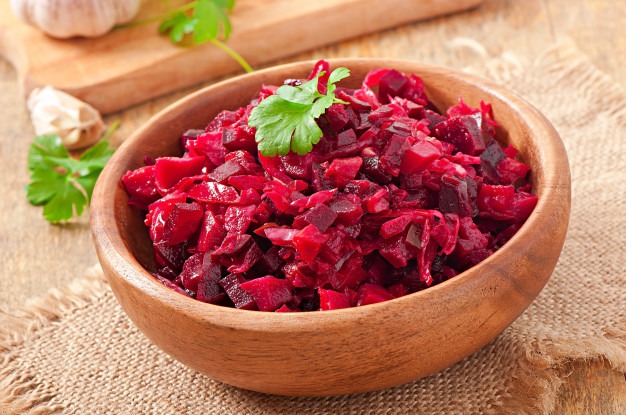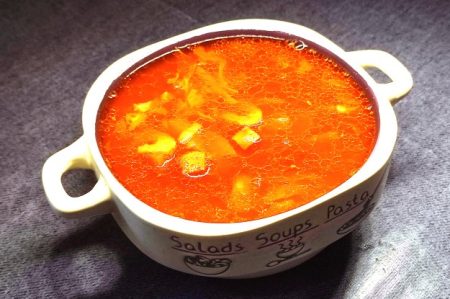Vinaigrette with sauerkraut is a magical New Year’s vegetarian recipe that you can make in 20 minutes if you have all boiled and salted ingredients in the house.
Each housewife prepares it in her way. We will show how to cook this salad, which is popular in Ukraine. The main trick is to find sauerkraut in the store or make your own. And also pre-cook vegetables.
Like many winter Ukrainian dishes, this salad is vitamin and colorful. Carrots and beets give the brightest colors, and they also belong to the ingredients of borsch. People joke that vinaigrette is a vegetarian borsch mix. Indeed, you can use leftover salad to prepare it. Just add the broth.
Directions
0/0 steps madeBoil beets, carrots, and potatoes. You can cook everything in one saucepan. Two hours on low heat is enough for the vegetables to become soft. Check to see if any vegetables are hard; cook some more. Especially watch out for beets; they are the most capricious.
- Cut as you like when the vegetables have cooled; cut them into cubes.
- Take out pickled cucumbers or cucumbers from brine and chop them. Large pieces give the salad a varied flavor.
- Peel the onions and cut them into large pieces. Remove the sauerkraut from the jar.
- Now combine all the ingredients in a large bowl. Serve with cold-pressed unrefined sunflower oil and chopped onion leaves or parsley. Do not salt, because cucumbers and sauerkraut contain salt.
How to Cook Sauerkraut
It looks like an interesting and unique twist on a classic vinaigrette recipe. The recipe calls for ingredients such as sauerkraut, olive oil, apple cider vinegar, honey, Dijon mustard, and garlic.
Sauerkraut is a fermented cabbage that is often used as a condiment or side dish in many cuisines. It is known for its tangy and slightly sour flavor and is a good source of probiotics.
The vinaigrette recipe uses sauerkraut as a base ingredient to add flavor and texture to the dressing. The sauerkraut is blended with other ingredients such as olive oil, vinegar, honey, mustard, and garlic to create a tangy and slightly sweet dressing that can be used to dress salads or as a dip for vegetables.
This vinaigrette with sauerkraut recipe seems like an interesting and flavorful option for those who enjoy the taste of sauerkraut and are looking for a new twist on a classic vinaigrette recipe.
Video by Ukrainian Homemade Dishes
Potential Pros of the Vinaigrette with Sauerkraut Recipe
Unique flavor. The sauerkraut adds a tangy and slightly sour flavor to the vinaigrette that is different from traditional dressings.
Probiotic benefits. Sauerkraut is a fermented food that contains beneficial bacteria that can aid in digestion and support a healthy gut.
Versatile. This vinaigrette can be used as a dressing for salads, a dip for vegetables, or as a marinade for meats.
Homemade. Making your vinaigrette allows you to control the ingredients and avoid any additives or preservatives that may be present in store-bought dressings.
Potential Cons of the Vinaigrette with Sauerkraut Recipe
Acquired taste. The tangy flavor of sauerkraut may not be to everyone’s liking.
High sodium. Sauerkraut can be high in sodium, so if you are watching your sodium intake, you may want to use it in moderation or look for low-sodium options.
Preparation time. Making this vinaigrette requires some preparation time to blend the ingredients together and allow the flavors to meld.
Refrigeration required. Due to the inclusion of sauerkraut, this vinaigrette must be stored in the refrigerator and may have a shorter shelf life than other dressings.
History of this Recipe
It is difficult to trace the exact history of Vinaigrette with Sauerkraut as a recipe, but we can look at the history of its key ingredients to gain some insight.
Sauerkraut has a long history and is believed to have originated in China over 2,000 years ago. It is made by fermenting shredded cabbage with salt and often other seasonings.
Sauerkraut was a popular food among sailors in the 18th century because it could be stored for long periods and was a good source of vitamin C, which helped prevent scurvy.
Vinaigrette dressing, on the other hand, originated in France in the 19th century. It is typically made with oil, vinegar, and seasonings and is used as a dressing for salads or as a marinade for meats.
The combination of sauerkraut and vinaigrette in a dressing is a more recent innovation, and its exact origin is unclear.





Recent comments